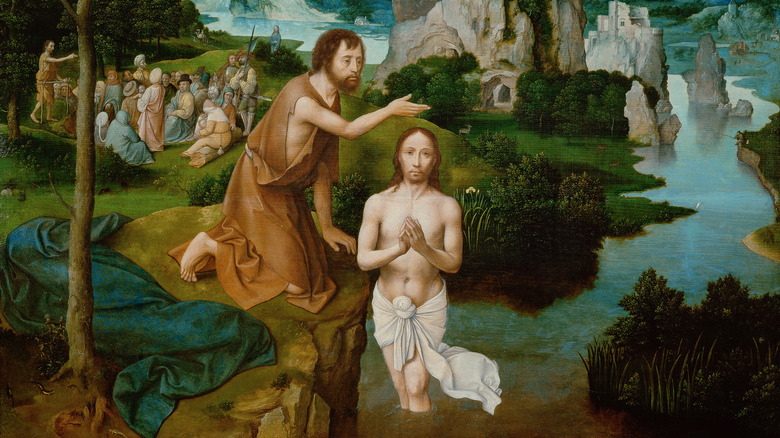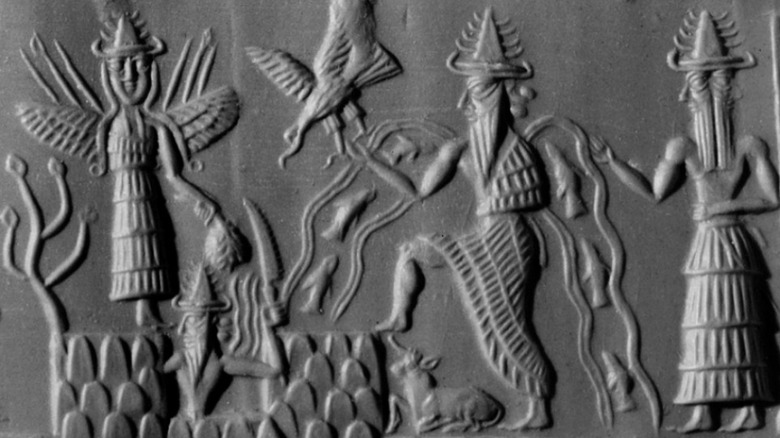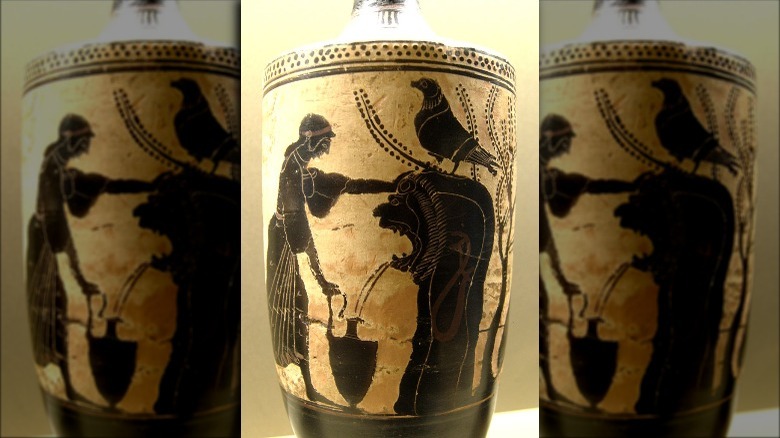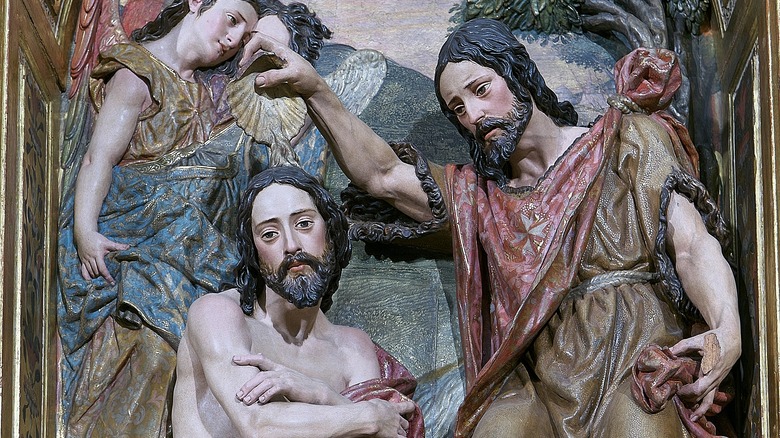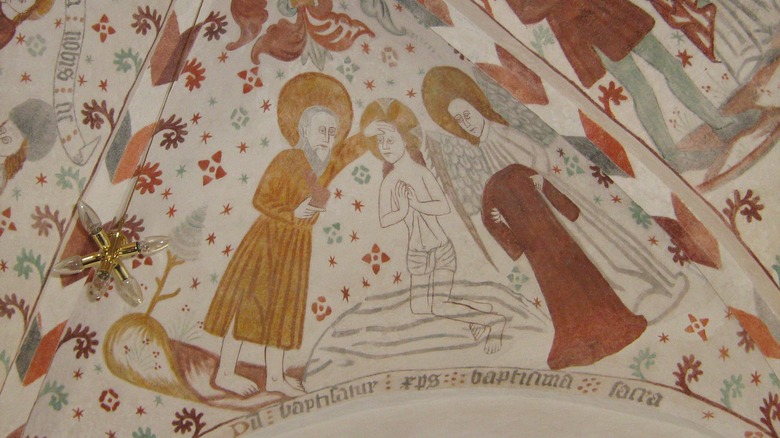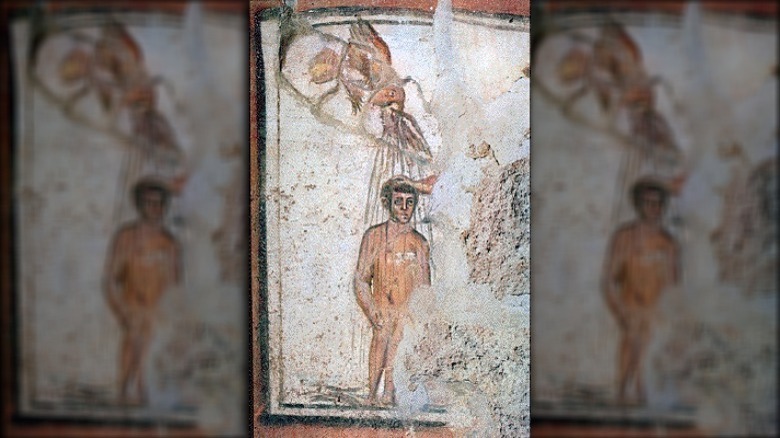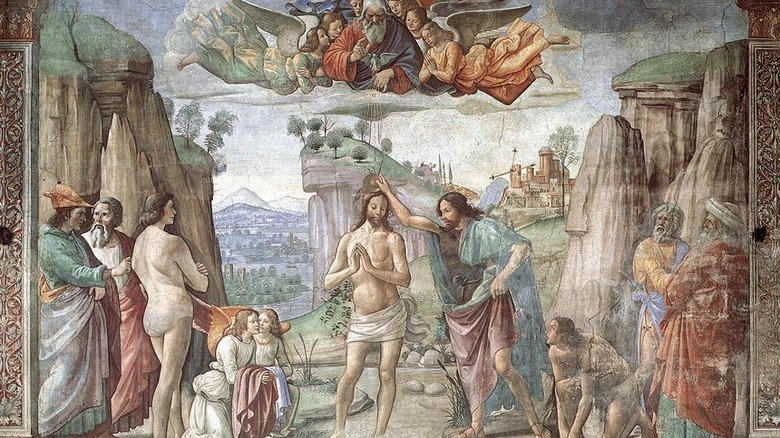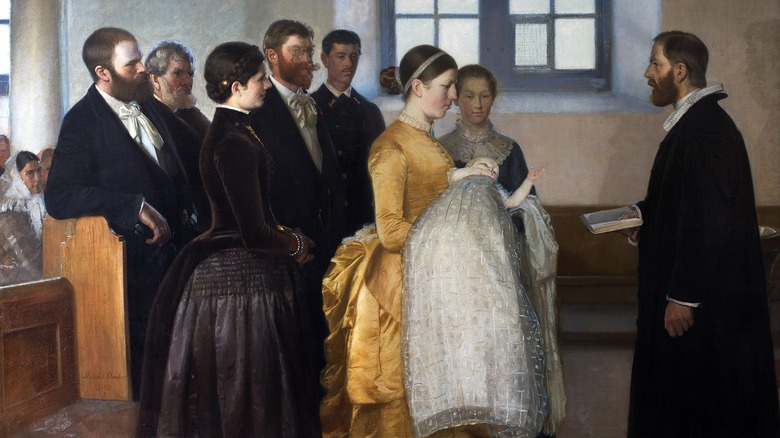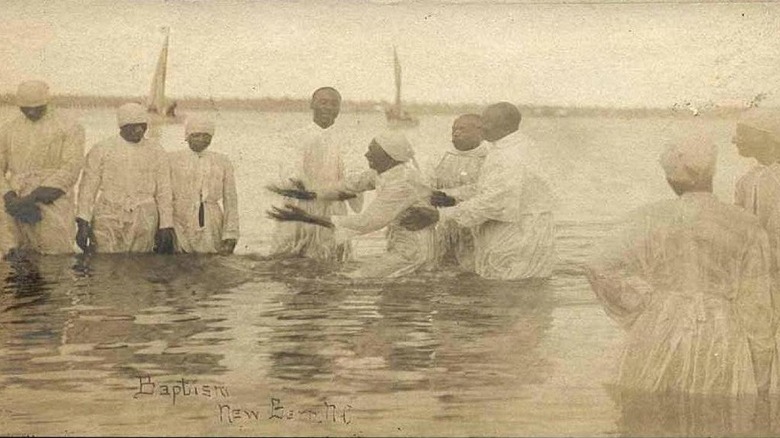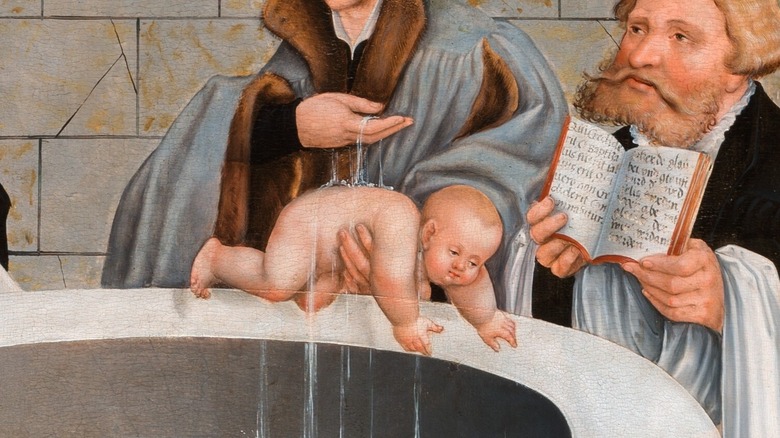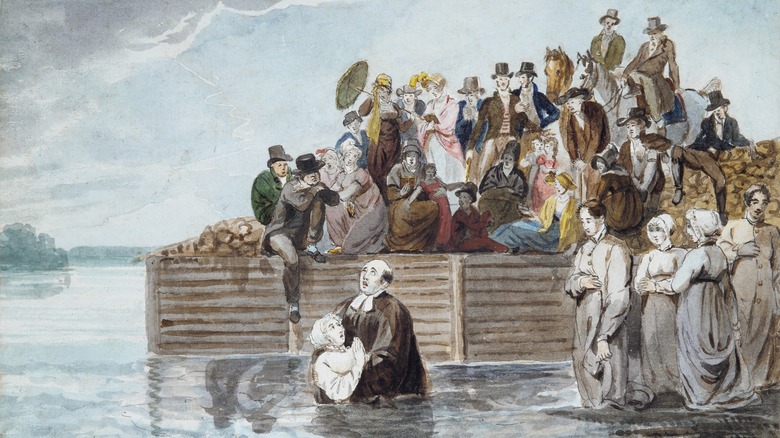The Untold Truth Of Baptism
On the surface of it, baptism may seem like a simple enough ceremony. Someone who wants to join a religious group or church undergoes a water-based ritual that marks their entry into the group. Sometimes, the ritual involves a full immersion into a pool or body of water, while on other occasions it's poured or sprinkled over the faithful's heads. So, there's a ceremony with some prayers, an invocation, the water, and then that's that, right?
Of course, baptism is more than a ritualistic dunking into a pool. It can be a profound religious ceremony that marks a major point in a believer's life, showing that they are a full and participating member of a particular church and its belief system. It's also an occasion marked by a rich history full of divergent opinions and, perhaps unsurprisingly to any student of theological history, plenty of arguing.
Baptism is not a purely Christian tradition. The practice dates back thousands of years and can be found in ancient Mesopotamia and ancient Egypt. Plus, modern non-Christian religions, including Judaism and Hinduism, have water immersion rituals that work an awful lot like the Christian baptism. Here's the untold truth of the complicated, deep, and profound practice known as baptism.
Baptism has pre-Christian origins
While many of us might assume that baptism is Christian, rituals based around water washing away impurities and sins are old. Records of baptism or baptism-like immersion rituals come from as far back as the world of ancient Mesopotamia, thousands of years ago, according to Encyclopedia.com. Water was central to the worship of Enki, a Sumerian god whose purview included not only clean water, but also knowledge, creation, and magic (via World History Encyclopedia).
The ancient Egyptians believed in the power of the River Nile's waters to cleanse and regenerate. It was linked to their myth of the resurrected god Osiris, and even the pharaoh was obliged to cleanse himself from time to time, according to the Journal of Egyptian Archaeology. The river was central to both the temporal and spiritual health of the ancient Egyptian people.
A very baptism-like ceremony also occurs in Hinduism. Per the BBC, the Namkaran, or naming ceremony, for a 40-day-old baby involves pouring a small amount of water over a child's head. And quite a few adult believers contend that immersion in India's Ganges River can help to cleanse them of sins and to break out of the burdensome reincarnation cycle (via Condé Nast Traveler).
Ancient Greeks believed that water rituals could transform and heal
The Egyptians and Babylonians were pretty keyed into the importance of water rituals, but the Greeks were even more interested in baptisms. Numerous ancient Greek texts and rituals refer to water immersion, per Encyclopedia.com, with some rituals even supposedly conferring immortality on the bather — though no one's come forth to confirm that particular rumor in the many years since.
Some ritual cults required that their devotees bathe in the ocean or a river before their initiation into deeper mysteries, in order to reach a state of ritual purity. And some who were part of the cult of Cybele skipped over the water businesses altogether and reportedly were baptized in the blood of a sacrificed animal. According to Britannica, in ancient Asia Minor, there was a ritual known a criobolium that involved the worship of both the great mother goddess Cybele and her consort, Attis, via a whole bunch of rams' blood. A later version, popular amongst some Romans, was called the taurobolium and switched out the ram for a bull.
Meanwhile, some ancient physicians focused more literally on water's role in keeping people and society healthy. The journal Water notes that, for many ancient people, medicine and religion were deeply intertwined, and that there is evidence that ancient Greek healing centers known as asclepieia required clean sources of water for their work. Texts left by ancient Greek physicians also include mention of the importance of clean water.
Ritual immersion is an important part of Judaism
Ritual bathing has been part of the Jewish religion for centuries, far before the tradition of Christian baptism was even though of. As the Biblical Archaeology Society reports, a dedicated ritual bath, known as a mikveh or mikvah, was uncovered in a Jerusalem excavation that dates back to a period spanning 538 BC to 70 AD. Visitors to the mikveh would have immersed themselves in collected rainwater, an important feature developed in accordance with religious law demanding ritual baths be taken in "living" water taken directly from a natural source, like a river or spring.
Mikvehs are still used in some Jewish communities to this day. The Jewish Women's Archive explains that women in modern Orthodox communities often use mikvehs to ritually purify themselves after menstruating or giving birth. In some places, the highly gendered nature of this practice, which hinges on the ritual impurity of a woman's body, has made it controversial and subject to a number of modern reinterpretations. The Washington Post notes that men may also use the mikveh on occasion, such as before important rituals or holidays, and that converts to Judaism may also choose to undergo a mikveh ritual to mark their transition.
Many point to John the Baptist as the originator of Christian baptism
The history of Christian baptism begins with the man who is now aptly known as John the Baptist. Of course, given that the gospels claim that John baptized an on-the-rise Jesus, he probably didn't think of himself as a Christian. Yet, his importance in the story of Jesus' life and the subsequent history of baptism cannot be overstated.
According to History, practically everything we know about this man comes from two sources: the Bible and "The Antiquities of the Jews," a work by Jewish historian Flavius Josephus. The bare bones of the story, as related by both Josephus and the gospels (specifically, the New Testament books of Matthew, Mark, Luke, and John) follow the same general line. John was apparently a compelling religious figure who, after emerging from a hermetic life in the desert, began telling people that the Messiah was coming. Given that said Messiah was probably also bringing divine justice, John said that this was a prime time to shed their sinfulness, get baptized, and prepare to meet him.
Though he drew many followers, John denied being the Messiah himself. And, when Jesus showed up and asked to be baptized in the River Jordan, John did so in what was likely a real historical event (via Bible.org). The immersion ritual overseen by John the Baptist was eventually interpreted as a key moment in both the life of Jesus and in the developing religion of Christianity.
Baptism didn't become an important Christian practice right away
Though it's mentioned in the Gospels and has since become a pretty big deal for many churches and their congregations, baptism doesn't appear to have reached prime importance until the 1st century AD, according to Britannica. Before then, the history of Christian baptism is quite a bit murkier, with some hints that it was a common ritual with widely varying particulars.
The exact details of how baptism was supposed to happen and whether it was necessary to become a Christian were topics of great discussion and, inevitably, argument. Even today, Britannica notes that historians can't clearly tell if it was considered absolutely necessary to become a Christian, or if it was only meant to reflect a more profound inner transformation.
We can at least be reasonably sure that baptism was widespread by the time of Paul, the devoted Christian convert and apostle who widely preached and founded numerous Christian enclaves in the wake of Jesus' crucifixion (via World History Encyclopedia). Though Paul was such a big deal that many modern scholars now credit him as one of the true founders of Christianity, he wasn't quite so focused on baptism as you might think. According to Interpretation: A Journal of Bible and Theology, baptism was important, but perhaps not key to Paul's zealous mission. It's sometimes even a minor detail to him, to the point where he doesn't quite remember who he's baptized.
Early secrecy around baptism created many misconceptions
In some ways, the practices of the early Christian church weren't unlike those of the ancient mystery cults practiced in Greece and beyond, where initiates were gradually introduced to the secret practices and beliefs of the group over a prolonged period of time. But, for the Christians, this sense of mystery, while compelling, may also have seriously backfired in those first few generations of the emerging religion.
For some communities, this push and pull of mystery and revelations became known as the disciplina arcani, according to the journal Logos. Specifically, disciplina arcani referred to the transfer of this sacred knowledge between those in the know and those deemed worthy to join in the inner circle of the religion. But this also meant that suspicious outsiders could seriously misinterpret the real inner life of the emerging religion.
Because practices like baptism and communion were kept so hush-hush via the disciplina arcani process, outsiders sometimes misinterpreted this secrecy. Some even believed that such things were hallmarks of a potentially dangerous cult. The discussion of the eucharist amongst Christians, for example, did refer to the body and blood of Christ. As "Christianity: The First Three Thousand Years" explains, outsiders who heard these snippets sometimes thought it meant that Christians were literally consuming human blood and flesh. Secret rituals like baptism were likewise viewed with suspicion, to the point where some Christian communities faced riots and other violence as they kept things close to their chests.
Baptism was a breaking point for many rival churches
Since it was eventually considered such a big step in becoming a Christian and member of a church, just how baptism was supposed to happen generated plenty of controversy. For some, an incorrectly performed baptismal ritual could put someone's very salvation in danger, so getting it right was of key importance. "History of Christianity" notes that, for some early Christian churches, it was possible that a bishop who performed baptisms could put his whole flock in danger if he wasn't perfectly pure. It may as well have been the Devil who baptized someone, some seemed to say.
People argued about details like triple immersion, representative of the Holy Trinity, and whether or not it was okay to simply pour water over someone while reciting the names of said trinity (via "Baptism in the Early Church").
Given all of the opportunities for argument and the seeming life or death nature of the questions, many church splits happened as a result of disagreements over baptism. According to Encyclopedia.com, much of the history of Christianity is marked by breakaway sects who often declared that they were the true church and were practicing the right kind of baptism. Some, like the Anomoeans, rejected the full triple immersion ceremony, while the Arians required that prospective members get re-baptized before joining their church. Both also argued that baptism didn't immediately confer God's grace upon a person, especially if the baptizing minister wasn't up to snuff.
What you wear to your baptism varies
Throughout history, baptisms have had a variety of dress codes. Per EWTN, early Christian baptisms were apparently performed while the candidate in question was nude, necessitating separate ceremonies for women and men. This also seems to have meant that, in quite a few cases, a portion of early baptisms would have been performed by women, who would have also filled in for priests on some occasions where a highly gender segregated society demanded it.
The nudity requirement for baptism appears to have fully died out by the Middle Ages, giving rise to the question: what do you wear to your own baptism? For infants, it was often a relatively nice gown for many generations, which can still be seen today in the extra long christening gown many infants are dressed in for some Christian denominations (via "The Greenwood Encyclopedia of Clothing Through World History: 1501–1800").
For adults, it's a bit trickier and largely depends on who's doing the baptizing. Some churches will baptize people in everyday clothes, while others require special garments. The Church of Jesus Christ of Latter-day Saints (LDS, also commonly known as the Mormon church) typically baptizes people wearing all-white garments, though it's key that said clothing doesn't turn transparent when wet, as full-body immersion baptisms are standard practice. Meanwhile, the person performing the baptism must also wear all white, as well as a temple garment — special underclothing that's granted to adult LDS members who have been endowed with certain promises and responsibilities within their faith, per Buzzfeed News.
There's more than one way to get baptized
Generally speaking, there are three types of baptism that a person can encounter: immersion, affusion/pouring, and aspersion/sprinkling. Per Owlcation, immersion generally involves a full or partial dip into a body of water, whether it's a natural feature or a man-made pool. It appears to have been the most common practice in the early Christian church, if it wasn't outright the only way to get baptized then.
Affusion, where water is poured on top of a person, reached its height of popularity in the early Middle Ages, around the 10th century in most places in and near Europe. Aspersion, where a small amount of water is sprinkled on a person's head, has often proven to be the most convenient method for people who can't manage a full immersion. Aspersion and affusion are the types of baptism you're most likely to encounter at a child's christening, though some churches like the Orthodox church will fully immerse infants in a symbolic imitation of Christ's death and rebirth (via Russia Beyond).
The type of baptism someone experiences depends largely on their church and faith traditions. Denominations that almost exclusively practice adult baptism tend towards full immersion, while those that make room for infant or child baptism tend to make room for less overwhelming methods.
The debate over infant baptism is still going on
If there is a single issue around baptism that's caused debate in Christianity, it's the issue of infant baptism. Essentially, the question seems simple. Should adults baptize a young child, or is it morally better to let them decide for themselves at a later age? But, as straightforward a quandary as that may seem on the surface, the various ways it's been answered have been complex and the debates over the matter are pretty heated.
The question of whether to baptize infants or adults was an early issue in the Christrian church and remains so today. Many still argue over the importance of infant versus adult baptism in the context of original sin, a doctrine that maintains humans inherit a tendency to sin at birth, per the BBC. For many churches and congregations that accept this doctrine, it's key that a baby get baptized relatively quickly after birth for the sake of their soul. Those who are more skeptical of the original sin concept or who reject it entirely tend to lean towards waiting until adulthood for baptism, when a person can make an informed decision to join a given church.
Of course, even seeming stalwarts of the early church, like Tertullian, could outright deny original sin, as "History of Christianity" notes, further complicating an already tangled, millennia-long argument.
Anabaptists took a hardline view of baptism
Beginning in the 16th century, one rather large segment of Christians began to draw away from infant baptism, creating a rather intense breakup within the church — though, of course, said church had already seen its fair share of anxiety and discord around baptism alone, not to mention any number of other theological quandaries. Still, this particular break proved to be one with some seriously long-lasting consequences for believers that can still be seen and felt today. Enter the Anabaptists.
Specifically, according to Encyclopedia.com, it was in 1517 that many people began to push back against infant baptism. The only way to properly become a Christian, they said, was to fully and consciously choose to do so once one was an adult. Children, they argued, couldn't fully comprehend the meaning of Christ's sacrifice and weren't yet ready to join the church. Collectively, these dissidents became known as Wiedertäufer or Anabaptists, for their insistence that adults wanting to join in the growing religious movement had to be rebaptized first.
Many Anabaptists were, unsurprisingly, subject to persecution, and some of their more vehement early leaders were even executed, per Britannica. Yet, the movement persisted and communities of Anabaptists (which also often preached other principles like communal living and egalitarianism) proliferated. Modern Anabaptists include the Hutterites, Mennonites, and Amish (via PBS), and you can also reasonably make the case that modern Baptists are theological descendants of this group, too.
